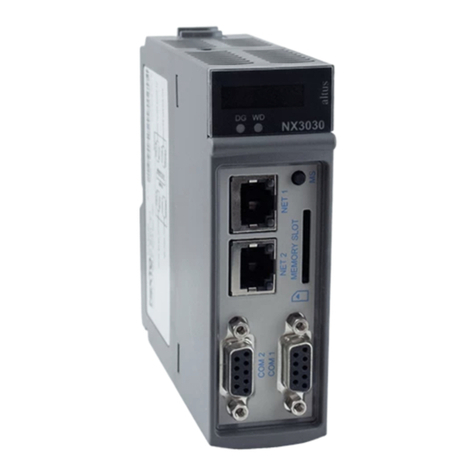
CONTENTS
5.7.7.1. MODBUS Ethernet Client Configuration via Symbolic Mapping . . . . . . . . . . 132
5.7.7.1.1. MODBUS Client Protocol General Parameters – Configuration via Sym-
bolicMapping.................................133
5.7.7.1.2. Device Configuration – Configuration via Symbolic Mapping . . . . . . . . 134
5.7.7.1.3. Mappings Configuration – Configuration via Symbolic Mapping . . . . . . 136
5.7.7.1.4. Requests Configuration – Configuration via Symbolic Mapping . . . . . . . 137
5.7.7.2. MODBUS Ethernet Client configuration via Direct Representation (%Q) . . . . . . 142
5.7.7.2.1. General parameters of MODBUS Protocol Client - configuration for Direct
Representation(%Q) .............................142
5.7.7.2.2. Device Configuration – Configuration via Direct Representation (%Q) . . . 143
5.7.7.2.3. Mapping Configuration – Configuration via Direct Representation (%Q) . . 144
5.7.7.3. MODBUS Client Relation Start in Acyclic Form . . . . . . . . . . . . . . . . . . 146
5.7.8. MODBUSEthernetServer ...................................146
5.7.8.1. MODBUS Server Ethernet Protocol Configuration for Symbolic Mapping . . . . . 146
5.7.8.1.1. MODBUS Server Protocol General Parameters – Configuration via Sym-
bolicMapping.................................146
5.7.8.1.2. MODBUS Server Diagnostics – Configuration via Symbolic Mapping . . . 148
5.7.8.1.3. Mapping Configuration – Configuration via Symbolic Mapping . . . . . . . 150
5.7.8.2. MODBUS Server Ethernet Protocol Configuration via Direct Representation (%Q) 151
5.7.8.2.1. General Parameters of MODBUS Server Protocol – Configuration via Di-
rect Representation (%Q) . . . . . . . . . . . . . . . . . . . . . . . . . . . 151
5.7.8.2.2. Mapping Configuration – Configuration via Direct Representation (%Q) . . 153
5.7.9. OPCDAServer .........................................155
5.7.9.1. Creating a Project for OPC DA Communication . . . . . . . . . . . . . . . . . . . 157
5.7.9.2. Configuring a PLC on the OPC DA Server . . . . . . . . . . . . . . . . . . . . . . 160
5.7.9.2.1. Importing a Project Configuration . . . . . . . . . . . . . . . . . . . . . . 162
5.7.9.3. OPC DA Communication Status and Quality Variables . . . . . . . . . . . . . . . 162
5.7.9.4. Limits of Communication with OPC DA Server . . . . . . . . . . . . . . . . . . . 163
5.7.9.5. Accessing Data Through an OPC DA Client . . . . . . . . . . . . . . . . . . . . . 164
5.7.10. OPCUAServer .........................................166
5.7.10.1. Creating a Project for OPC UA Communication . . . . . . . . . . . . . . . . . . . 167
5.7.10.2. Types of Supported Variables . . . . . . . . . . . . . . . . . . . . . . . . . . . . . 169
5.7.10.3. Limit Connected Clients on the OPC UA Server . . . . . . . . . . . . . . . . . . . 169
5.7.10.4. Limit of Communication Variables on the OPC UA Server . . . . . . . . . . . . . 169
5.7.10.5. Encryption Settings . . . . . . . . . . . . . . . . . . . . . . . . . . . . . . . . . . 169
5.7.10.6. Main Communication Parameters Adjusted in an OPC UA Client . . . . . . . . . . 170
5.7.10.6.1. EndpointURL.................................170
5.7.10.6.2. Publishing Interval (ms) and Sampling Interval (ms) . . . . . . . . . . . . . 170
5.7.10.6.3. Lifetime Count and Keep-Alive Count . . . . . . . . . . . . . . . . . . . . 171
5.7.10.6.4. Queue Size and Discard Oldest . . . . . . . . . . . . . . . . . . . . . . . . 171
5.7.10.6.5. Filter Type and Deadband Type . . . . . . . . . . . . . . . . . . . . . . . . 171
5.7.10.6.6. PublishingEnabled, MaxNotificationsPerPublish and Priority . . . . . . . . 171
5.7.10.7. Accessing Data Through an OPC UA Client . . . . . . . . . . . . . . . . . . . . . 172
5.7.11. EtherCATMaster ........................................173
5.7.11.1. Installing and inserting EtherCAT Devices . . . . . . . . . . . . . . . . . . . . . . 173
5.7.11.1.1. EtherCAT - Scan Devices . . . . . . . . . . . . . . . . . . . . . . . . . . . 174
5.7.11.2. EtherCAT Master Settings . . . . . . . . . . . . . . . . . . . . . . . . . . . . . . 175
5.7.11.2.1. EtherCAT Master - General . . . . . . . . . . . . . . . . . . . . . . . . . . 175
5.7.11.2.2. EtherCAT Master - Sync Unit Assignment . . . . . . . . . . . . . . . . . . 177
VI






























